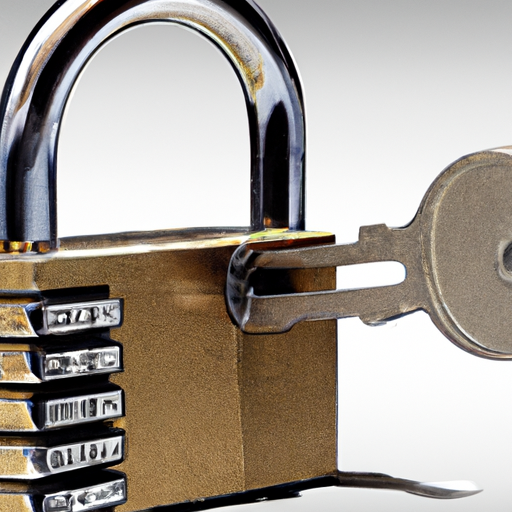Why Is Backing Up Data Important For Cybersecurity?
In today’s digital age, the need to protect our personal and sensitive information is more crucial than ever. That’s why backing up data plays a vital role in ensuring the security of our online presence. By creating duplicate copies of our important files and storing them in a separate location, we can safeguard ourselves against potential cyber threats and unexpected data loss. Whether it’s a malicious cyberattack or a hardware failure, having a secure backup of our data acts as a safety net, providing peace of mind and allowing us to quickly recover and restore our information. So, let’s explore the importance of backing up data for cybersecurity and the steps we can take to protect ourselves in the digital realm.
Data loss
Data loss can occur due to various reasons, such as hardware failure, software malfunction, accidental deletion, or even malicious attacks. Regardless of the cause, the consequences of data loss can be devastating. Losing important files, documents, or even entire databases can lead to significant setbacks for individuals and businesses alike. To prevent such situations and ensure the safety of your valuable data, it is crucial to have a reliable backup system in place.
Causes of data loss
Data loss can be caused by a multitude of factors. Hardware failure, such as a crashed hard drive or a damaged storage device, is one of the most common causes. Additionally, software issues, such as system crashes or corrupted files, can also lead to data loss. Human errors, including accidental deletion or overwriting of files, can have severe consequences. Furthermore, malicious attacks, such as ransomware or viruses, can encrypt or delete valuable data, rendering it inaccessible.
Consequences of data loss
The consequences of data loss can be far-reaching and detrimental to both individuals and businesses. For individuals, losing personal files, cherished memories, or important documents can be emotionally distressing. It can also result in the loss of valuable work or educational materials. In a business context, data loss can lead to financial losses, reputational damage, and even legal ramifications. Critical customer information, financial records, or intellectual property can be irretrievably lost, jeopardizing the future of the organization.
Importance of data backup for data loss prevention
To prevent the devastating effects of data loss, it is essential to have a robust data backup strategy. Data backup involves creating copies of important files and storing them in a secure location. By regularly backing up your data, you can ensure that even if the original files are lost or damaged, you can restore them from the backup copies. This not only protects against hardware and software failures but also provides a much-needed safeguard against accidental deletion, malicious attacks, and other unforeseen events. Having a reliable backup system gives you peace of mind and allows for efficient data recovery in case of any data loss incidents.
Ransomware Attacks
Ransomware attacks have become increasingly prevalent in recent years, posing significant threats to individuals and organizations. Understanding the nature of ransomware attacks and their potential consequences can help highlight the importance of data backup as a defense mechanism.
Definition of ransomware attacks
Ransomware attacks involve malicious software that encrypts the victim’s files, making them inaccessible until a ransom is paid to the attacker. This type of attack can be devastating, as it not only denies access to critical data but also puts individuals and businesses in a difficult situation. Ransomware attacks can occur through various means, including malicious email attachments, infected websites, or compromised software.
How ransomware attacks can lead to data loss
Once a ransomware attack successfully encrypts the victim’s files, the data becomes virtually unusable until the ransom is paid and a decryption key is provided. If the victim does not have a backup of the encrypted data, they face a difficult choice between losing the data permanently or paying the ransom, which can be a costly and uncertain process. In some cases, even if the ransom is paid, there is no guarantee that the attacker will provide a working decryption key, leaving the victim with irretrievable data loss.
Role of data backup in ransomware protection
Having a secure and up-to-date data backup is crucial in protecting against ransomware attacks. By regularly backing up your files, you create a copy of your data that is not vulnerable to encryption or deletion by ransomware. In the event of an attack, you can simply restore your files from the backup and minimize the impact of the ransomware. It is important to ensure that your backup system is not directly accessible from the network or compromised devices to prevent the ransomware from infecting the backup as well. Regularly testing the efficiency and reliability of your backup system is also crucial to ensure its effectiveness in mitigating the damage caused by ransomware attacks.
Natural Disasters
While cyber threats often come to mind when discussing data loss, the impact of natural disasters on data security should not be overlooked. Natural disasters such as floods, fires, earthquakes, or hurricanes can destroy physical infrastructure, including servers and storage devices, leading to extensive data loss. In such situations, safeguarding your data through proper backup mechanisms becomes paramount.
Impact of natural disasters on data security
Natural disasters can have a devastating effect on data security. When servers, data centers, or storage devices are physically destroyed or damaged beyond repair, the data they contained may be lost forever. This can include critical business data, customer information, or historical records that may be impossible to recreate. In addition to the loss of data, natural disasters can disrupt communication networks, power supply, and other infrastructures, further exacerbating the impact on data security and recovery.
Ensuring data integrity through backup in disaster situations
Having an offsite backup strategy is essential in disaster situations. By storing copies of your data in a remote location, away from the primary infrastructure, you can protect against physical damage caused by natural disasters. Cloud storage or remote data centers offer viable options for offsite backup, providing secure and reliable storage for your critical data. Regularly backing up your data to the offsite location ensures that even if the primary infrastructure is destroyed or offline, you can still recover your data and resume normal operations.
Recovering from data loss due to natural disasters
Recovering from data loss caused by natural disasters can be a challenging process. However, having a comprehensive backup strategy significantly simplifies the recovery process. After the infrastructure has been restored or replaced, you can retrieve your backed-up data and restore it to the primary systems. This minimizes the downtime and allows for faster recovery of critical functions. Regularly testing the recovery process and ensuring the integrity of the backed-up data is essential to ensure a smooth and successful recovery in the aftermath of a natural disaster.
Human Error
While external threats often dominate discussions on data loss, human error remains one of the leading causes of data loss incidents. Accidental deletion, overwriting files, or misplacing storage devices can have severe consequences. However, with the right backup mechanisms in place, the impact of human error can be minimized, and data can be quickly recovered.
Common human errors that lead to data loss
Human errors can take various forms, and they can lead to data loss incidents. Accidental deletion of files is one of the most common errors, often caused by mistaken keystrokes or erroneous actions. Overwriting files unintentionally or mistakenly formatting storage devices can also result in the loss of valuable data. Furthermore, misplacing or losing storage devices, such as USB drives or external hard drives, can lead to irreversible data loss if backups are not available.
Prevention and recovery strategies through data backup
The first and most effective step in preventing data loss due to human error is to establish a regular backup routine. By routinely backing up your data, you create multiple points in time from which you can recover in case of accidental deletion or file mishaps. It is important to have a backup system that allows for the retrieval of previous versions of files, enabling you to recover data from a time before the error occurred. Additionally, educating individuals about the importance of data backup and providing clear guidelines on file management can help reduce the incidence of human errors that lead to data loss.
Minimizing the impact of human error with data backup
By having a reliable backup system in place, the impact of human error can be significantly minimized. In the event of accidental deletion or file corruption, you can quickly restore the affected files from the backup copies. The ability to retrieve previous versions of files also allows for quick recovery from unintentional modifications or overwriting. Regularly testing the backup system and ensuring that backups are up to date ensures that even in the face of human error, data can be easily recovered, reducing any potential downtime or loss of critical information.
Physical Damage
Data loss is not solely limited to digital threats. Physical damage to storage devices, such as hard drives or servers, can also result in significant data loss incidents. Understanding the risks of physical damage and implementing backup strategies specifically designed to protect against such risks is crucial for data security.
Physical damage risks to data storage devices
Data storage devices are susceptible to various physical damage risks. Mishandling, such as dropping or exposing devices to extreme temperatures or humidity, can cause internal damage, rendering the devices inoperable and leading to data loss. Additionally, disasters like fires, floods, or accidental spills can irreparably damage storage devices, wiping out valuable data. It is essential to recognize these risks and take proactive measures to protect against physical damage.
Protecting against physical damage through backup
Backup solutions play a vital role in protecting against physical damage to storage devices. By periodically creating copies of your data and storing them in secure locations, you can ensure that even if the primary devices are damaged, you can recover your data. Cloud storage or offsite backup facilities provide robust solutions for protection against physical damage. By utilizing these backup options, you create redundancy and reduce the risks associated with physical damage.
Mitigating the consequences of physical damage with backups
In the unfortunate event of physical damage to your storage devices rendering the data inaccessible, having reliable backups is essential for mitigating the consequences. By restoring the data from the backup copies, you can regain access to critical information and resume operations with minimal disruption. Regularly testing the integrity and accessibility of the backup files ensures that they are ready for use when needed. Implementing a proactive approach to physical damage risks through backup solutions can save individuals and businesses from the severe consequences of data loss.
Malicious Attacks
Malicious attacks targeting data, such as hacking, phishing, or malware infections, pose significant threats to cybersecurity. Understanding the different forms of attacks and the role of data backup in mitigating their impact is essential for safeguarding sensitive information.
Types of malicious attacks targeting data
Malicious attacks come in various forms and can target data directly or indirectly. Hacking involves unauthorized access to systems or networks, allowing attackers to manipulate or steal data. Phishing aims to deceive individuals into revealing sensitive information, such as usernames or passwords, which can be used to compromise data security. Malware, including viruses, trojans, or ransomware, can infect systems, leading to data loss, encryption, or other harmful effects. Understanding the nature of these attacks is crucial for implementing effective countermeasures.
The importance of data backup for mitigating the impact of attacks
Data backup serves as a critical defense against malicious attacks. By having secure and up-to-date backups, even if your data is compromised, you can restore your files from a known good state, minimizing the impact of the attack. Backup systems provide an additional layer of protection as they are not directly accessible from compromised systems or networks. Ransomware attacks, for example, can be rendered ineffective if you have regular backups of your data, as you can restore the files without having to pay the ransom. A combination of proactive security measures and reliable backups significantly enhances data protection against malicious attacks.
Recovering data after a malicious attack with backups
Recovering data after a malicious attack becomes significantly easier and more efficient with the presence of backups. Once the attack has been contained and the compromised systems or networks have been secured, you can restore your data from the backup copies. This ensures a clean start, free from any compromises introduced by the attack. Regularly testing the restoration process and verifying the integrity of the backed-up data is essential to ensure smooth recovery and minimize downtime after a malicious attack.
Compliance and Legal Obligations
Data protection regulations and legal requirements have become increasingly stringent in recent years. Organizations must adhere to compliance standards, including data backup requirements, to safeguard sensitive information and fulfill legal obligations.
Compliance requirements for data backup
Various compliance regulations, such as the General Data Protection Regulation (GDPR), require organizations to have appropriate measures in place for data backup and recovery. These regulations often outline specific requirements, including the frequency of backup, data retention periods, and the ability to restore data in case of a breach or data loss incident. Failure to comply with these regulations can result in severe penalties and legal consequences.
Legal obligations regarding data protection and backup
In addition to compliance requirements, there are legal obligations regarding data protection and backup that organizations must fulfill. These obligations differ across jurisdictions but generally emphasize the need to safeguard customer information, financial records, and other sensitive data. In case of data loss or breaches, organizations may be required to demonstrate that they had taken reasonable measures to protect the data and ensure its recovery. Having a comprehensive data backup system in place demonstrates a proactive approach to data protection and aids in meeting legal obligations in case of any incidents.
Using backup for compliance and legal purposes
An effective data backup strategy not only helps organizations meet compliance and legal requirements but also serves as evidence of due diligence in data protection. Regularly backing up data in accordance with regulatory demands ensures that organizations can comply with data retention and recovery obligations. In the event of legal disputes or investigations, having comprehensive backups can provide the necessary evidence to support the organization’s position and demonstrate compliance efforts. By integrating data backup into their overall compliance and legal strategies, organizations can mitigate risks and protect themselves from potential penalties and legal liabilities.
Business Continuity
Data loss can have a significant impact on business continuity, jeopardizing operations, customer trust, and overall profitability. Incorporating data backup as part of a comprehensive business continuity plan is crucial for ensuring smooth operations during and after any cyber incident.
Data backup as part of a business continuity plan
A robust business continuity plan includes measures to safeguard critical data and ensure its availability in case of disruptions or incidents. Data backup plays a pivotal role in this plan by providing a means to restore critical files, applications, and databases in a timely manner. By integrating data backup into the overall business continuity strategy, organizations can minimize downtime, mitigate financial losses, and maintain customer trust even in the face of data loss incidents.
Ensuring operations during and after a cyber incident
Cyber incidents, such as data breaches or ransomware attacks, can severely disrupt operations. By having a reliable and up-to-date data backup system, organizations can ensure the availability of critical data and quickly recover affected systems. This enables them to continue essential operations, maintain customer service, and minimize the impact of the incident on revenue and reputation. Regularly testing the recovery process and updating the backup system as needed are essential steps to ensure that operations can resume smoothly during and after a cyber incident.
Restoring critical functions with proper data backups
In the aftermath of a cyber incident, the ability to restore critical functions is of utmost importance. Data backup systems provide organizations with the means to retrieve critical data and restore affected systems to a working state. By prioritizing the restoration of critical functions and utilizing the backups effectively, organizations can minimize the disruption caused by the incident and resume normal operations promptly. Ensuring the integrity and accessibility of the backups and having clear recovery procedures in place are vital for a successful restoration of critical functions.
Preventing Data Theft
In today’s digital landscape, data theft poses a significant threat to individuals and organizations. Criminals seek to gain unauthorized access to sensitive information for various purposes, such as identity theft, financial fraud, or corporate espionage. Implementing data backup measures is a key component in protecting against data theft.
Data theft risks in the digital landscape
The digital landscape exposes individuals and organizations to various data theft risks. Hackers or cybercriminals may target systems, networks, or websites to gain access to personal and sensitive information. Phishing attacks lure individuals into divulging confidential information, such as passwords or credit card details. Additionally, insider threats, where employees or individuals with authorized access misuse or leak data, are also a significant concern. Understanding these risks is crucial in devising effective countermeasures.
Using backup to protect against data theft
Data backup serves as an essential tool in protecting against data theft. By having secure backups of your sensitive data, you can ensure that even if unauthorized access occurs, the stolen data remains encrypted or inaccessible. Backup systems that offer encryption options further enhance data security, rendering the stolen data useless to the attackers. Additionally, having backups of critical systems and databases enables quick recovery and reduces the impact of data theft incidents on operations and customer trust.
Securing sensitive information with data backups
Implementing proper data backup measures is crucial in securing sensitive information. By regularly backing up sensitive data and storing it securely, organizations can protect against data theft or unauthorized access. This includes implementing encryption techniques to protect the data both during transit and at rest. Ensuring that backup systems and their access controls are well-protected further enhances the security of sensitive information. By incorporating data backup into the overall cybersecurity strategy, organizations can effectively safeguard against data theft incidents and maintain the confidentiality of critical data.
Data Recovery
While the emphasis is often on data backup for data loss prevention, the importance of data recovery should not be overlooked. Data recovery refers to the process of retrieving and reinstating lost or corrupted data, ensuring minimum downtime and allowing for seamless operations.
Importance of data recovery in cybersecurity
Data recovery is an integral part of cybersecurity, as it enables organizations to restore operations quickly after a data loss incident. While data backup provides copies of the data, data recovery focuses on the retrieval and reinstatement of the data to its original state. The ability to recover data efficiently and reliably ensures that organizations can resume operations promptly, minimize disruptions, and maintain continuity.
Utilizing backups for fast and reliable data recovery
Backup systems play a critical role in data recovery. By having reliable and up-to-date backups, organizations can retrieve lost or corrupted data and restore it to its pre-incident state. The speed and reliability of the data recovery process are of utmost importance to minimize downtime and ensure business continuity. Regularly testing the restoration process and verifying the integrity of the backups are essential steps to enhance the efficiency and reliability of data recovery.
Ensuring minimal downtime with efficient data recovery solutions
Efficient data recovery solutions are essential to ensure minimal downtime and operational disruptions. By employing backup systems that offer fast and reliable recovery options, organizations can swiftly recover from data loss incidents. This includes leveraging technologies such as incremental backups, which only back up changes since the previous backup, reducing the time required for data restoration. Additionally, regularly evaluating and updating data recovery solutions ensures that they align with changing business requirements and technological advancements, enhancing their effectiveness in minimizing downtime and supporting business continuity.
Click here to discuss your Cybersecurity needs with our team.







